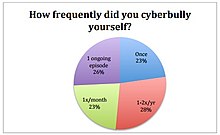Auto-trolling

Auto-trolling, self-cyberbullying, digital Munchausen or digital self-harm is a form of self-abuse on the Internet.[2][3] It is usually done by teenagers posting fake insults on social media, attacking themselves to elicit attention and sympathy.[2] A study in 2012 found that about 35 per cent of those who did this felt better.[2][1] Studies in 2016 and 2019 found an increase in prevalence in American adolescents rising from 6 to 9 per cent.[3][4][5] In a 2011 study, boys were more likely than girls to admit to digital self-bullying.[6] In a 2022 study published by researchers Justin Patchin, Sameer Hinduja, and Ryan Meldrum,[7] US youth who engaged in digital self-harm were between five and seven times more likely to have considered suicide and between nine and fifteen times more likely to have attempted suicide.
In the UK, a woman was cautioned in 2009 for trolling herself on Facebook and then jailed for 20 months for repeat offences during 2011–12.[8]
Though digital self-harm can be done in various ways, it is usually done in a public or semi-public setting.[9] Researchers Rinjani Soengkoeng and Ahmed Moustafa suggest that there are three types of digital self-harm.[10] These are:
- social development (either determine if one's friends would defend them or prove one's resilience)
- personal gain (sympathy or entertainment)
- manifestation of negative emotions (which can derive from mental health issues,stressors, or social rejection).[10]
These appear to be common reasons for digital self harm according to Sameer Hinduja and Justin W. Patchin's 2017 study of American middle and high school students.[11]
Contributing factors[edit]
Common correlations to digital self-harm include bullying,[12] depression, negative emotionality, and sleep deprivation.[13][14][15] There is also research that suggests digital self-harm and physical self-harm have similar causes and motivations.[16] The two seem to be positively associated with physical self-harm[17] and suicidal thoughts and behaviors.[18]
Prevention[edit]
Identifying and preventing digital self-harm is arguably more difficult than its offline counterpart. For one, it is hard for parents to monitor their child's online presence.[15] Taking away internet access completely is usually impractical, as the internet is important for gaining important information from the outside world.[19][9] There is a need to create strategies for digital self-harm prevention, as it is not the same as physical self harm or suicide.[19] Due to anonymous apps such as Yik Yak, Whisper, and Secret, it is more difficult to track digital self-harm without possible invasion of privacy. Research by Dr. Sujita Kumar Kar suggests that "calling out" the behavior of digital-self harm may be counterproductive.[13] Instead, encouragement to change online behavior may more beneficial in the long term.[13]
References[edit]
- ^ a b Englander, Elizabeth (June 2012), Digital Self-Harm: Frequency, Type, Motivations, and Outcomes (PDF), Massachusetts Aggression Reduction Center
- ^ a b c Ktena, Natalie (2018-05-16). "These teens secretly trolled themselves online". BBC Three. Retrieved 2020-01-23.
- ^ a b "Why more young Americans are cyber-bullying themselves", The Economist, 11 January 2020
- ^ Juli Fraga (21 April 2018), When Teens Cyberbully Themselves, NPR
- ^ Patchin, Justin; Hinduja, Sameer (2017), "Digital Self-Harm Among Adolescents", Journal of Adolescent Health, 61 (6): 761–766, doi:10.1016/j.jadohealth.2017.06.012, PMID 28935385, S2CID 3650036
- ^ Ken Corish (2014), "Waving Silently - Technology and Self-harm", Every Child Journal, Imaginative Minds Group, archived from the original on 2023-02-09, retrieved 2020-07-21
- ^ Fairbank, Rachel. "What Parents Need to Know About 'Digital Self-Harm'". LifeHacker.
- ^ Maria Tadeo (5 February 2014), "Woman becomes first person to be jailed for 'trolling herself'", The Independent
- ^ a b Ramluggun, Pras; Small, Myra (6 January 2022). "Understanding digital self-harm and its implications for mental health practice". Mental Health Practice. 25 (1). RCN Publishing Company. doi:10.7748/mhp.2021.e1592 (inactive 31 January 2024). ISSN 1465-8720.
{{cite journal}}: CS1 maint: DOI inactive as of January 2024 (link) - ^ a b Soengkoeng, Rinjani; Moustafa, Ahmed A. (9 March 2022). "Digital self-harm: an examination of the current literature with recommendations for future research". Discover Psychology. 2 (1): 19. doi:10.1007/s44202-022-00032-8. ISSN 2731-4537. S2CID 247381023.
- ^ Patchin, Justin W.; Hinduja, Sameer (December 2017). "Digital Self-Harm Among Adolescents". Journal of Adolescent Health. 61 (6). Elsevier: 761–766. doi:10.1016/j.jadohealth.2017.06.012. ISSN 1054-139X. PMID 28935385. S2CID 3650036. ProQuest 1970948534.
- ^ Cyberbullying Prevention and Response: Expert Perspectives. New York: Routledge. 23 June 2011.
- ^ a b c Pacheco, Edgar; Melhuish, Neil; Fiske, Jandy (1 May 2019), Digital Self-Harm: Prevalence, Motivations and Outcomes for Teens Who Cyberbully Themselves, Rochester, NY, doi:10.2139/ssrn.3374725, S2CID 197744883, SSRN 3374725
{{citation}}: CS1 maint: location missing publisher (link) - ^ Meldrum, Ryan C.; Patchin, Justin W.; Young, Jacob T.N.; Hinduja, Sameer (4 March 2022). "Bullying Victimization, Negative Emotions, and Digital Self-Harm: Testing a Theoretical Model of Indirect Effects". Deviant Behavior. 43 (3): 303–321. doi:10.1080/01639625.2020.1833380. ISSN 0163-9625. S2CID 225133032.
- ^ a b Semenza, Daniel C.; Meldrum, Ryan C.; Testa, Alexander; Jackson, Dylan B. (May 2022). "Sleep duration, depressive symptoms, and digital self-harm among adolescents". Child & Adolescent Mental Health. 27 (2). Wiley Blackwell: 103–110. doi:10.1111/camh.12457. ISSN 1475-357X. PMID 33763977. S2CID 232354527.
- ^ Erreygers, Sara; Symons, Michelle; Vandebosch, Heidi; Pabian, Sara (1 January 2022). "Fictitious online victimization: Exploration and creation of a measurement instrument". New Media & Society. 24 (1): 156–177. doi:10.1177/1461444820960079. hdl:10067/1716470151162165141. ISSN 1461-4448. S2CID 225000344.
- ^ "Suicide prevention for physicians: identification, intervention and mitigation of risk". Journal of Indian Association for Child and Adolescent Mental Health. 2021.
- ^ Franklin, Joseph C.; Ribeiro, Jessica D.; Fox, Kathryn R.; Bentley, Kate H.; Kleiman, Evan M.; Huang, Xieyining; Musacchio, Katherine M.; Jaroszewski, Adam C.; Chang, Bernard P.; Nock, Matthew K. (2017). "Risk factors for suicidal thoughts and behaviors: A meta-analysis of 50 years of research". Psychological Bulletin. 143 (2): 187–232. doi:10.1037/bul0000084. ISSN 1939-1455. PMID 27841450. S2CID 3941854.
- ^ a b Kar, Sujita Kumar; Arafat, S. M. Yasir (January 2021). "Digital self-harm in adolescents: Strategies of Prevention". Journal of Indian Association for Child & Adolescent Mental Health. 17 (1): 137–141. doi:10.1177/0973134220210110. ISSN 0973-1342. S2CID 250992997.
